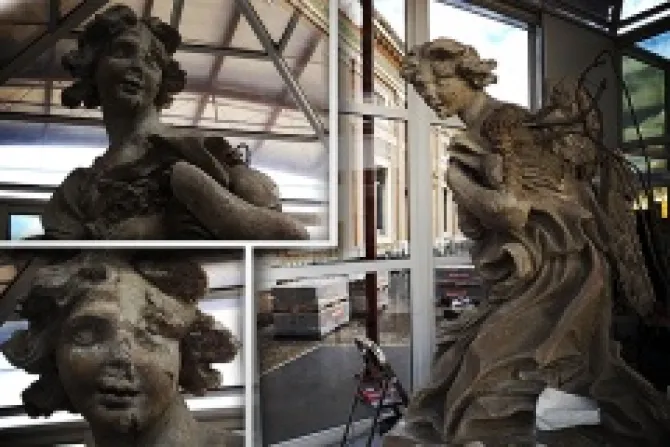Vatican City, Nov 7, 2013 / 11:08 am
Artists restoring key sculptures in the Vatican Museums, including some by famed Italian Gian Lorenzo Bernini, stress that the figures are rich in history and treasures in a "throw-away" culture.
"Obviously whenever you are dealing with a treasure, with something that's been passed down to us from century to century, you want to take care of it and you want to get it right," Father Mark Haydu told CNA in a Nov. 4 interview.
"If you make a mistake, it could be gone and if it's gone, it's gone forever. We live in a throw-away society, it's hard to imagine that we can't really get it back."
Fr. Haydu is the international director of the Patrons of the Arts of the Vatican Museums – a worldwide community dedicated to the restoration and conservation of artwork within the museums through the financial adoption of various projects.
The Vatican Museums, founded by Pope Julius II, are an immense collection of different pieces of art located within Vatican City which have come into the Catholic Church's possession throughout the centuries.
One of the various initiatives undertaken by the Patrons is the restoration of "Bernini's Angels," the un-fired clay models used to create the angelic bronze sculptures placed on either side of the main altar inside of Saint Peter's Basilica.
The current angel undergoing the restoration process, originally crafted in 1674, "is the preliminary model for the fusion of one of the angels in the Most Holy Sacrament, one of the most important chapels of San Pietro," restorer Alice Balteri revealed in a Nov. 4 interview with CNA.
These angels were originally designed and built in the school of Gian Lorenzo Bernini, a leading sculptor in the 15th century, and were touched up by the artist himself before the bronze castings were completed.
"In these works," Balteri said, "we obviously have the opportunity to find things never seen before; the impression of his fingers, signs of the work, impressions of the fingertips, signs of the instruments used to smooth the clay."
Usually, she explained, the models, made out of clay and straw, were thrown away or recycled once they were finished, but "in this case they were conserved because in 1700 there was a sort of museum, art gallery for the artists where the plastercasts, models, and other various things were exposed."
"We work meticulously," to repair the cracked clay, the artist noted, "because today a substance does not exist that is capable of consolidating this material in the same way without staining or changing in time."
"This angel is the prototype," she said indicating the sculpture being restored, "was made on a different scale and, never having been cast in bronze, it is the only model. A copy of this angel in bronze does not exist."
Balteri expressed her excitement about working specifically with the un-baked clay, "because while in the works in bronze, at the end the surfaces are clean, they are treated, they are smoothed. In these works, we obviously have the opportunity to find things never seen before."
"Sometimes," she noted, "there are also included things you'd never think of, the hair of the artists for example embedded in the clay, that really make you feel 'in the moment' of when the work was created."
Other projects being preserved through the generosity of the Patrons include the Holy Stairs, the stairs that Jesus walked up to be judged by Pontius Pilate, as well as an excavation site underneath the parking garage of the Vatican.
Preservation of these works, Fr. Haydu urged, is important because "when you can clean, restore and give it a smile, give it a twinkle in its eye, it attracts, it captivates and then it can communicate its message."
Whether that message be "theological, spiritual, human," he stressed, "it really helps all of the 5 million visitors coming through each year to be startled, struck, by the beauty of a work of art."



